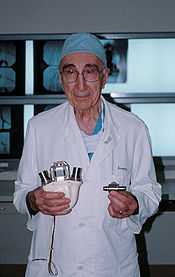Lebanese American
   _crop.jpg) • •     .jpg)      Ralph Nader • Kathy Najimy • Christa McAuliffe • Jamie Farr • Michael E. DeBakey Helen Thomas • Darrell Issa • Tiffany Tony Shalhoub • John E. Sununu • James Abourezk Rima Fakih • Ray LaHood • Marlo Thomas | |
| Total population | |
|---|---|
|
504,499 0.16% of total population (2009)[1] 3,300,000 Americans have at least partial Lebanese ancestry. | |
| Regions with significant populations | |
| Michigan, California, New York, Florida, Ohio, Massachusetts, Texas, Louisiana.,[2] Illinois, Pennsylvania, Arizona, New Jersey, Washington | |
| Languages | |
| American English, Arabic | |
| Religion | |
|
90% Roman Catholicism and Orthodoxy, with minorities of Shias and Sunnis and Judaism. | |
| Related ethnic groups | |
| Other Lebanese people and Arab diaspora, Jewish Americans and Jewish diaspora, Israeli Americans, Syrian Americans, Turkish Americans, Cypriot Americans, Egyptian Americans, and Armenian Americans |
Lebanese Americans (Arabic: أمريكيون لبنانيون) are Americans of Lebanese descent. This includes both those who are native to the United States as well as Lebanese immigrants to America.
Lebanese Americans are the largest Arab group in America, comprising 0.16% of the American population as of the American Community Survey estimations for year 2007, and 32.4% of all Arab Americans.[3] Over three million Americans are estimated to have at least partial Lebanese ancestry according to Lebanese American activists.[4] Lebanese-Americans have historically excelled in business, academia, arts and entertainment and have had a significant participation in American politics and social and political activism.
History
The first known Lebanese immigrant to the United States was Antonios Bishallany, a Maronite Christian, who arrived in Boston Harbor in 1854. He died in Brooklyn, New York in 1856 on his 29th birthday.[5] Large scale Lebanese immigration began in the late 19th century. They settled mainly in Brooklyn and Boston, Massachusetts. While they were marked as Syrians, the vast majority of them were Christians from Mount Lebanon. Upon entering America, many of them worked as peddlers. This wave continued through the 1920s. During the first wave, an estimated 100,000 Lebanese had immigrated to America.[6] Many immigrants settled in Northern New Jersey, in towns such as Bloomfield, Paterson, Newark, and Orange. Some immigrants set out west, with Detroit, Michigan and Peoria, Illinois, gaining a large number of all Lebanese immigrants. Others bought farms in states such as Texas, South Dakota and Iowa. Large numbers came via the United Kingdom including a large number on the ill-fated liner RMS Titanic.
The second wave of Lebanese immigration began in the late 1940s and continued through the early 1990s, when Lebanese immigrants had been fleeing the Lebanese Civil War. Between 1948 and 1985, over 60,000 Lebanese entered the United States. Since then, immigration has slowed down to an estimated 5,000 immigrants a year, and those who do settle these days are predominately Muslim, different from the predominately Christian population of immigrants during all previous waves.
Religion
Most of the Lebanese immigrants during the first and the early part of the second waves were Christians. Muslims followed in large numbers beginning in the late 1960s. Among Muslims, the Shi'ite and Sunni communities are the largest. A number of Jews fled Lebanon for the United States due to fears of persecution, and populations of Druze and atheists also exist.[7] This information has been distributed by all American organizations, including the Arab American Institute and the United States census team.
Places with sizable populations

Dearborn, Michigan has the highest concentration of Arab Americans in the United States, at over 40%.[8] The rest of Metro Detroit has an even larger population of Lebanese residents. Brooklyn, New York has one of the oldest Lebanese populations in America, dating over 125 years; one large center is in the Bay Ridge section. Once predominately Christian, the Lebanese in Bay Ridge are today equally split between Muslims and Christians. South Paterson, New Jersey historically had a large Lebanese Christian population dating back to the 1890s, but only a few remain, and the neighborhood has largely been replaced by new Palestinian immigrants. Brooklyn holds a significant Lebanese community, with a Maronite Cathedral the center of one of two eparchies for Maronite Lebanese in the United States, the other being in St Louis.
Utica, New York; San Diego, California; Jacksonville, Florida; Sterling Heights,

Michigan; Los Angeles County; San Francisco, California; Peoria, Illinois; Grosse Pointe, Michigan; Miami, Florida; Wichita, Kansas; Bloomfield, Michigan; Fall River, Massachusetts; Worcester, Massachusetts; Boston, Massachusetts; Methuen, Massachusetts; Lawrence, Massachusetts; Salem, New Hampshire; Lansing, Michigan; East Grand Rapids, Michigan; Lafayette, Louisiana; St. Clair Shores, Michigan; Toledo, Ohio and Houston, Texas also have sizeable Lebanese communities.[8]
The Arab American Institute reports the top five states where Lebanese Americans reside are: Michigan (11%), California (9%), Ohio (6%), Florida (6%), and Massachusetts (5%).[9]
Famous Lebanese-Americans or Americans of Lebanese descent
See also
References
- ↑ "B04001. Total Ancestry Reported". 2009 American Community Survey. U.S. Census Bureau. Retrieved 2011-04-08.
- ↑ Every Culture - Lebanese American
- ↑ American FactFinder
- ↑ Lebanese Americans
- ↑ Middle East Curriculum
- ↑ Lebanese Americans: Information and Much More from Answers.com
- ↑ Lebanese Americans, Celebrities, Photos and Information
- ↑ 8.0 8.1 U.S. Arab population doubles over 20 years - News
- ↑ The Arab American Institute
External links
![]() Media related to Lebanese American at Wikimedia Commons
Media related to Lebanese American at Wikimedia Commons
| ||||||||||||||||||||||||||||||||||||
| |||||||||||||||||||
| ||||||||
